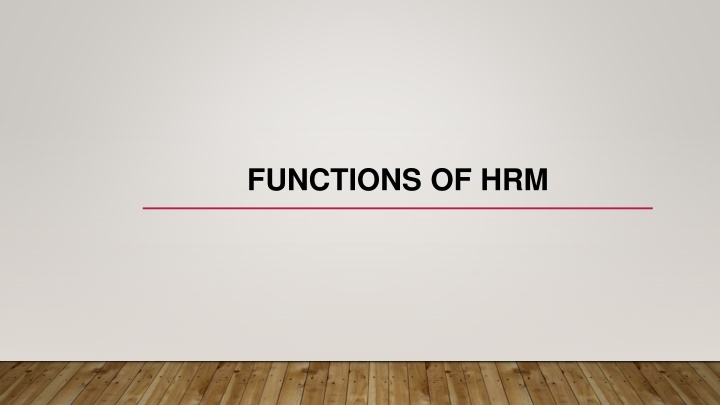
Comprehensive Guide to Functions and Perspectives of Human Resource Management
Explore the functions of HRM, including managerial and operational aspects, along with the normative and critical perspectives. Learn about various functions such as planning, staffing, development, integration, and more. Understand the concepts of hard and soft HRM models and how they shape organizational strategies. Delve into the different dimensions of human resource management to enhance your understanding of HR practices.
Download Presentation

Please find below an Image/Link to download the presentation.
The content on the website is provided AS IS for your information and personal use only. It may not be sold, licensed, or shared on other websites without obtaining consent from the author. If you encounter any issues during the download, it is possible that the publisher has removed the file from their server.
You are allowed to download the files provided on this website for personal or commercial use, subject to the condition that they are used lawfully. All files are the property of their respective owners.
The content on the website is provided AS IS for your information and personal use only. It may not be sold, licensed, or shared on other websites without obtaining consent from the author.
E N D
Presentation Transcript
MANAGERIAL FUNCTIONS OF HRM 1. Planning: Research and plan about wage trends, labour market conditions, union demands and other personnel benefits.Forecasting manpower needs etc. 2.Organizing:Organizing manpower for the achievement of organizational goals and objectives. 3.Staffing:Recruitment & Selection 4. Directing: Issuance of orders and instructions, providing guidance and motivation to managers and employees. 5. Controlling: Regulating personnel activities and policies according to plans. Observations and comparisons of deviations
OPERATIONAL FUNCTIONS OF HRM 1.Procurement:Planning,Recruitment and Selection,Induction and Placement 2.Development:Training,Development,Career planning and counselling. 3.Compensation:Wage and Salary determination and administration 4.Integration:Integration of human resources with organization. 5. Maintenance: Sustaining and improving working conditions, retentions, employee communication 6. Separations: Managing separations caused by resignations, terminations, lay offs, death, medical sickness etc.
12 FUNCTIONS OF HRM: 1. Human resource planning 2. Recruitment and selection 3. Performance management 4. Learning and development 5. Career planning 6. Function evaluation 7. Rewards 8. Industrial relations 9. Employee participation and communication 10. Health and safety 11. Personal wellbeing 12. Administrative responsibilities
PERSPECTIVE OF HRM 1.The Normative Perspective The normative perspective of human resource management bases itself on the concepts of hard HRM and soft HRM, on which the foundations of human resource management rest. The concept of Hard HRM is the basis for the traditional approach toward human resource management.This concept traces its origins to the Harvard model that links workforce management to organizational strategy. Hard HRM stresses the linkage of functional areas such as manpower planning, job analysis, recruitment, compensation and benefits, performance evaluations, contract negotiations, and labor legislations to corporate strategy. This enforces organization interests over the employees' conflicting ambitions and interests.It views the workforce as passive resources that the organization can use and dispose at will. Soft HRM is synonymous with the Michigan model of human resources and is the bedrock of the modern approach to strategic human resource management. This model considers human capital as assets rather than resources and lays stress on organizational development, conflict management, leadership development, organizational culture, and relationship building as a means of increasing trust and ensuring performance through collaboration.This approach works under the assumption that what is good for the organization is also good for the employee.
2.The Critical Perspective of Human Resource Management The critical perspective of human resource management is a reaction against the normative perception.This highlights some inherent contradictions within the normative perspective. This perspective espouses a gap between rhetoric, as organizations claim to follow soft HRM policies when they actually enforce hard HRM. A study by Hope-Hailey et al. (1997) finds that while most organizations claim employees to be their most important assets and make many commitments for their welfare and development, in reality employers enforce a hard HRM-based strategic control,and the interests of the organization always take priority over the individual employee.
3.The Behavioral Perspective of Human Resource Management The behavioral perspective of human resource management has its roots in the contingency theory that considers employee behavior as the mediator between strategy and organizational performance. This theory holds that the purpose of human resource intervention is to control employee attitudes and behaviors to suit the various strategies adopted to attain the desired performance. This perspective thus bases itself on the role behavior of employees instead of their skills,knowledge,and abilities. For instance, an organization aiming to innovate will require a workforce that demonstrates a high degree of innovative behavior such as long-term focus, cooperation, concern for quality, creativity, propensity for risk taking, and similar qualities. The role of human resource management in such a context is to inculcate and reinforce such behavioral patterns in the workforce.
4.The Systems Perspective of Human Resource Management The systems perspective describes an organization in terms of input, throughput, and output,with all these systems involved in transactions with a surrounding environment.The organized activities of employees constitute the input,the transformation of energies within the system at throughput, and the resulting product or service the output. A negative feedback loop provides communications on discrepancies.
The role of human resource management in the systems perspective is 1. Competence management to ensure that the workforce has the required competencies such as skills and ability to provide the input needed by the organization. 2. Behavior management through performance evaluation, pay systems, and other methods to ensure job satisfaction, so that employees work according to the organizational strategy, ultimately boosting productivity. 3. Setting up mechanisms to buffer the technological core from the environment in closed systems. 4.Facilitating interactions with the environment in open systems.
